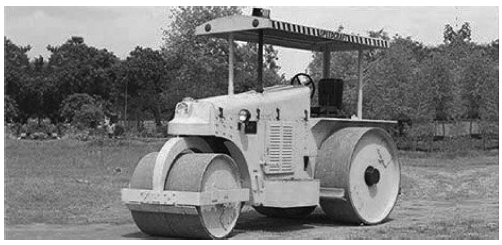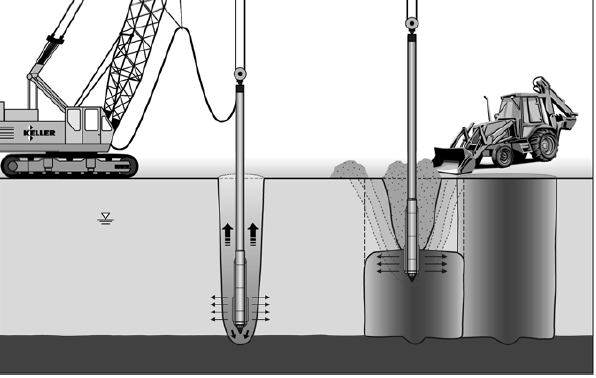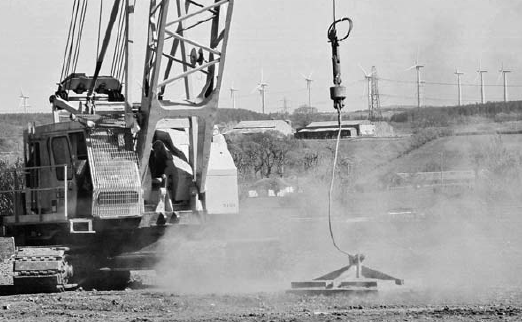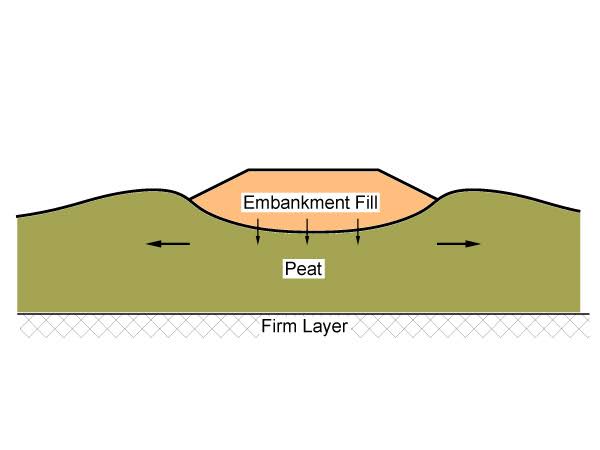The choice of a foundation type does not necessarily have to alternate between deep and shallow options due to poor ground conditions.

Arriving at the choice of foundation depends largely on the ground conditions uncovered during site investigations. When faced with poor ground conditions, there are a number of strategies that can be employed towards realizing the project objectives. Perhaps, the most obvious of them all is to find another site. However, this is rarely practicable. Aside the location of certain structures being fixed by default, there is also the need to build on poor soil, partly necessitated by surging land scarcity. An alternative strategy available to the project team is to redesign the structure taking adequate consideration of the prevailing ground conditions. This might involves reducing the size of the structure which consequently reduces the load it applies on the ground. Still another option is to completely by-pass the poor ground by adopting a deep foundation.
The aforementioned ‘avoiding’ strategies can be found to be cost effective and very good solutions. However, they may also be found to be unrealistic in principle. Hence, the prevailing ground conditions must be dealt with. This is done through a process known as ‘Ground Improvement.’ Ground improvement is the modification or treatment of weak and loose soil in order to improve their bearing capacities and potential settlement characteristics. Ground improvement has proved to be a very economical foundation solution to many sub-structural developments.
The objectives of any ground improvement procedure can be summarized into one or the combination of the following
- Increase in the ground shear strength and density, consequently improving bearing capacity.
- Reduction in the ground compressibility to minimize total or differential settlement.
- Reduction in the ground permeability to minimize movement of ground water.
In actual sense, the problem associated with providing or designing foundations in poor soils is that the foundations are highly given to differential settlements. Hence, the first and basic aim of any ground improvement method is to reduce differential settlements and create a more uniform settlement from the applied loads. Since settlements are caused by the weight of a superstructure and its sub-structure, resulting in consolidation, the whole concept of ground improvement is to consolidate and compact soil, thereby increasing it shear resistance and improve it drainage characteristics. This reduces differential settlement and increases the bearing capacity of soils.
There are numerous types of ground improvements methods available. But only some of most commonly used ones are presented in this article, these are:
- Surface Rolling
- Vibro-Stabilization
- Dynamic Consolidation
- Grout Injection
- Preloading
- Reinforced Soils
Surface Rolling
Surface Rolling involves the importation of suitable materials to be spread over a layer of a loose soil after which they are compacted. In surface rolling, the materials are selected with the aim of obtaining an appropriate size and grade that will suit compaction and economy. The materials are usually granular and well graded. This doesn’t mean other materials cannot be used. However, an important consideration in the choice of this materials is the labour and cost. Since it’s sensible to keep the labour and cost as low as possible, hence the need to be selective.

Just as the name implies: ‘surface rolling’, dry loose granular materials are sprayed over the soil desiring ground improvement and a plant roller (Figure 1) is operated on the surface, compacting the granular materials until no further movement occurs on the surface, or to a specified number of passes of the roller.
The most suitable sites for treatment by surface rolling are those where compaction of a loose well graded granular material of shallow depth is required. In such cases a small number of passes with a specified vibrating roller until no further movement of the surface is apparent can achieve a much-improved bearing capacity with reduced total and differential settlement. The roller searches out the softer areas and continue to vibrate-roll until no further movement occurs. The most needed locations will record a higher number of passes.
Fine sands, silty sands, silty sandy gravels, demolition rubble and other mainly granular mixtures can be treated by this method.
Vibro-Stabilization
The use of vibration techniques to improve ground conditions is known as Vibro-Stabilization. This procedure was invented in the 1930s. The method originally involved the compaction of deep layers of loose sand by using a vibrating poker inserted into the ground. The vibration reduces the void ratio and increases the compaction of the sand and thus its density, strength and settlement resistance. Although it was originally intended for treatment of loose sands, the technique has been developed and can now be used to strengthen fills and cohesive soils by forming within them stone columns known as granular compaction points or gravel piles.

The procedure (Figure 2) involves a poker first vibrated into the soil under its own weight, assisted by air or water jetting, to the required depth for treatment. At this point the bottom jets are closed and jetting takes place through the top of the vibration unit. The compaction process of the soil is achieved by gradually withdrawing the poker in predetermined steps – usually 300–600 mm – with the compaction process held for between one and two minutes in each step. In granular materials a cone shaped depression tends to develop at ground level around the poker indicating that compaction is occurring. Well graded backfill material is constantly fed into the space formed around the poker, or through the shaft to a bottom feed as it is withdrawn, so that a column or pile is formed and the compaction of the soil is completed. The process can achieve compaction in the soil around the poker ranging from 1.2–3 m in diameter (See Video 1).
While vibro-stabilization is the general term used to cover ground improvement or stabilization using a vibrating poker to achieve deep compaction, there are three distinct techniques. These are explained briefly below:
- Vibro-compaction: This method is used to compact granular (non-cohesive) soils, and may employ stone columns in finer grained materials. The method may be wet or dry to suit groundwater conditions.
- Vibro-displacement: This method is used to improve cohesive materials, employing the dry process to form compacted stone columns within the clays.
- Vibro-replacement: This method is used to improve soft cohesive materials. Using the wet process, disturbed materials are washed away and replaced by compacted stone columns – alternatively in some soils the dry process using a bottom-feed method via a hopper and supply tube direct to the toe of the vibrator is adopted.
Dynamic Consolidation
Any ground improvement procedure that causes consolidation by repeated surface tamping using a heavy weight dropped on the ground surface is known as a Dynamic Consolidation procedure. The weights (or tamper) are usually between 10–20 tons, and dropped from a height of between 10–20m (Figure 3).

A tamper is dropped on a grid pattern over the whole site area. The process is repeated two to five times until the consolidation required is achieved. The number of repetitions or passes is dependent upon soil conditions. The times between successive passes are also related to soil permeability (See Video 2).
Dynamic consolidation has been found to be a very cost-effective ground improvement procedure for relatively large areas where mobilization costs can be absorbed more easily. Unlike vibro-stabilization that considers only localized zones of the site, dynamic consolidation on the other hand is a treatment for the entire footprint of the site. However, application of dynamic consolidation requires some levels of care as it effects on surrounding structures and foundations can be very detrimental. A clearance zone in the range of 30m is usually appropriate.
Grout Injection
Grouting involves the injection of fluids like materials into the ground. The idea is to fill voids occurring in the ground (fissures in rock and porosity in sediments). The following are the objectives of a grouting procedure:
- Increase resistance against deformation3
- Supply cohesion, shear, and uniaxial compressive strength3
- Reduce conductivity/transmissivity via interconnected porosities in an aquifer (this is the most common goal)3.
Grouting uses fluids like thin mortars, particulate suspensions, aqueous solutions, and chemical products like polyurethane, acrylates, or epoxy injected into the ground under pressure, via boreholes and packers, providing the geometrical layout of ‘points of attack’ in the underground space. By displacing gas or groundwater, these fluids fill pores and fissures in the ground.
Grouting technique can be further sub-divided into at least 6 different types. These are briefly explained below.
Hydro-fracture Grouting
Here, the grouting is done by infusing the grout under pressure into the ground and by this, the fissures or voids in the ground or rock becomes deliberated. Consequently, the ground shear strength improves (See Video 3). Typically, this technique is utilized to compact and stiffen the ground, especially grounds where the voids are inaccessible.
Compaction Grouting
Compaction grouting injects a very stiff grout material into the ground, forming grout bulbs which displaces the ground and consequently densify the soil around without penetrating the soil pores (See Video 4). In compaction grouting, the grout is not designed to penetrate the voids, it displaces them in granular soils. Thus, the volume of voids is basically reduced however, the idea is to not have the resulting compaction to maximum density.
Permeation Grouting
Permeation grouting as the name implies is generally used to reduce soil permeability while improving the shear strength of the ground. In this technique, the voids in the ground are filled with Grout such that the soil or rock is left undisturbed (See Video 5).
Compensation Grouting
The alternating use of hydro-fracture, compaction and permeation Grouting culminates into what is known as ‘compensation grouting.’ The basic aim is to minimize as far as possible the movement of the ground which could otherwise affect existing structures. For example, Tunnel excavations.
Jet Grouting
Jet grouting seems like an exception to the aforementioned techniques because it doesn’t necessarily involve Injection. It can be considered to be a type of soil mixing. This method utilizes a high velocity back pressure to hydraulically shear the soil after which the soil is blended with grout to form a soil-grout mixture (See Video 6).
Choice of Grouting
In order to choose a grout type, several properties of grout need to be taken into account. This would normally include, rheology, setting time, toxicity, strength of grout and grouted soil, stability or permanence of the grout and grouted soil, and the penetrability and water tightness of the grouted soil. In the field, the grouting method requires an extensive consideration on the grout hole equipment, distance between boreholes, length of injection passes, number of grouting phases, grouting pressure and pumping rate4.
Preloading
Originally developed in the 1940s this ground improvement method was mainly utilized in the construction of highways. However, these days they are more commonly applied on buildings, flood control structures and so forth. The basis of preloading is to have a fill placed on the construction site, typically thicker than the final design fill (Figure 4). This would cause settlement to occur at a more rapid rate than it would otherwise have occurred without the fill. The preload is ideally left in place until it has settled more than the total amount that the design fill is expected to settle in its design life. Then the thickness of the preload fill is reduced to the final design thickness with the expectation that most of the settlement has now finished.

There are two methods that can be utilized in applying the preload. These are:
- Preloading by Surcharging
- Preloading with Vacuum.
Preloading by Surcharging
Preloading by surcharging involves constructing an embankment 10% to 20% higher than the final design. When the ultimate settlement under the design height has been reached, the surcharge will be removed. The use of preloading by surcharge is arguably the simplest and cheapest method to accelerate the process of consolidation. However, its application is limited for at least two reasons. First, it takes longer time to consolidate the sub soil, secondly the shear strength of the sub soil might be insufficient to support the surcharge leading to excessive deformation and ultimately failure.
Preloading with Vacuum
Preloading with Vacuum on the flip side involves placing a layer of impermeable plastic material over the area to be treated. Vertical drains accelerate consolidation by providing short, horizontal drainage paths. In this method the pore water pressure is reduced to below atmospheric level by a pumping system. Surcharge is applied through the difference between the atmospheric pressure which acts on the membrane and the negative pore water pressure (See Video 7). Vacuum preloading has a major advantage over surcharge preloading: no embankment construction is required.
Reinforced Soil
In the construction of foundations, fibre reinforced soils have become a very viable technique of ground improvement for very poor soils. Its various applications include retaining structures, embankments foundations, slopes pavement etc. The basic principle involves adding natural or synthesized additive to the sub soil in order to alter and improve it geotechnical properties. These additives are known as soil reinforcements. When added to a sub soil, to be effective, they must intersect a potential failure surface in the soil mass. Strains in the soil mass will generate strain in the reinforcement which in turn manifests as tensile stress in the reinforcement. Consequently, the desired geotechnical properties of the soil are improved.

There are several reinforcement methods available for stabilizing extremely problematic soils. This article will not go into further details, the reader may find more information on this ground improvement method in the literatures listed in the ‘Sources & Citation’ section of this article.
Conclusion
This article has covered only the most common ground improvement methods available. It is generally accepted that geotechnical engineering is still a relatively new subject, hence the ground improvement methods listed in this article cannot be treated as exhaustive. Aside other methods such as lightweight fills, ground freezing, soil nails micro-piles and thermal pre-compression, there are new merging technologies and ideas with high prospect of future application. The reader can read-up on this from the texts in the ‘Sources & Citation’ section of this article.
See: Site Investigation in Foundation Design
Sources & Citations
- Curtin W.G., Shaw G., Parkinson G.I., Golding J.M, and Seward N.J (2006) Structural Foundation Designer’s Manual. 2nd ed. Blackwell Publishing.
- Bujang B.K., Arun P., Sina K., and Vivi A (2020) Ground Improvement Techniques. 1st Ed. New York: CRC Press.
- Klaus K., and Alan B (2013) Ground Improvement. 3rd ed. New York: CRC Press.
Thank You!